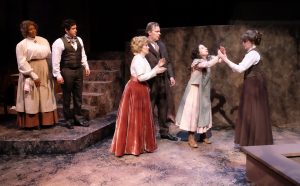Lamb’s’ ‘Miracle Worker’ Is Good, But Story Is Better Suited to Film
In 1962, The Miracle Worker, William Gibson’s film adaptation of his Broadway play from three years before, won two Academy Awards after being nominated for five. Anne Bancroft scored an Oscar for her portrayal of baggage-laden Anne Sullivan, whose headstrong deaf-blind student Helen Keller would become one of the world’s foremost advocates for sociopolitical equality. Patty Duke, at 16 the youngest Academy Award winner at the time, did the same for her portrayal of Keller.
The 1959 live production went the movie two better. It won four Tony nods, including Best Play, with Bancroft taking honors for her Sullivan role and Arthur Penn (who would later helm the movie) winning Best Director. Duke’s work as Keller netted her a Theatre World award.

Viney and James Keller (from left, Yolanda Franklin and Charles Evans Jr.) look on as Kate and Arthur Keller (Cynthia Gerber and Jason Heil) oversee a tentative meeting between Helen Keller and Anne Sullivan (Lucia Vecchio and Kelsey Venter). Photos by John Howard.
But the Robert Smyth-directed piece loses a lot, not only in its relative brevity but also in its compact worldview. Keller’s colossal presence on the global scene requires an almost journalistic approach to her life and the God-given miracle that was her epiphany. The movie is thus a far better vehicle for edification on Keller’s essence. By all means, see the show, but be advised that you have a larger-scale choice of exposure.
By rights, Gibson should hold a place alongside Tennessee Williams and Arthur Miller as one of America’s playwriting elite. He’s the same incredibly versatile guy responsible for the quirky romance-drama Two for the Seesaw and Golda’s Balcony, an account of Golda’s Meir’s life after her emigration from Russia; he’s an absolute master at culling subtext from characters and situations, and no matter the genre, he succeeds across the board.
… a bout of scarlet fever may have been responsible for her turn for the worse at 19 months.
Here, he’s focused on not one American hero but two, and he exploits Sullivan’s dark past (her oppressive education at Boston’s Perkins School for the Blind; the eye disease that cost her much of her sight; her father’s abandonment of her and her brother Jimmie; her wholesale illiteracy as a child) in order to enlighten us on both women. He’s left us a lot of understory centering on Capt. Arthur Keller and wife Kate and their haplessness in dealing with Helen’s handicaps in the Tuscumbia, Ala. of the late 19th century. Helen was born in Tuscumbia with hearing and sight in 1880; a bout of scarlet fever may have been responsible for her turn for the worse at 19 months. Keller died at Easton, Conn. in 1968 at age 87.
Helen’s tantrums and manipulation of her household are no match for the casehardened Sullivan’s persistence — the climax is evident in the legendary water scene, wherein Helen first realizes that things have names beyond fingerspelling. The family’s a unit once again, and Sullivan’s hire has become infinitely more than a stab in the dark.

The stage is set for Helen’s (Lucia Vecchio, left) epiphany as Anne Sullivan (Kelsey Venter) does the honors.
It’s those two weeks wherein we realize that Keller and Sullivan are reflections of one another, and Vecchio and Venter perform with all the according histrionics and love of their roles. Sullivan wordlessly hands Helen’s brother James his ass as Helen leaves her shell for good — and actor Charles Evans Jr. nicely portrays the effect. I’ve always liked Cynthia Gerber in roles that suit her upfrontedness; Kate is one of those parts. Jason Heil succeeds as Captain Keller – he and Evans also play the story’s most one-dimensional characters. Yolanda Franklin is excellent comic relief as housemaid Viney, but there’s no mistaking whose side of the household she’s on.
The stage is simply not the proper home for every work that happens to express itself in words…
If the show’s first few minutes are sustained by the tech, the rest of them are commanded in large part by fight choreographer Jordan Miller. Miller’s job becomes much more difficult in that the brawls involve only two people; he’s done great work in spite of the limitation. Everybody else’s tech effort is well thought and maintained.
But anyway:
John Steinbeck won a 1937 Drama Desk award for the play adaptation of his novel Of Mice and Men — even so, he called his effort “a failure.” In many ways, he was right. The story of George Milton and Lennie Small’s quest for a life off the fat of the land makes an OK staging — but its extraction from the book precludes Steinbeck’s wonderful narrative sense and uncommonly rich feel for cadence on the printed page. The stage is simply not the proper home for every work that happens to express itself in words; and while Lamb’s’ The Miracle Worker has its many virtues, the performing arts ain’t always big enough for both a live and a recording stage. This time, the spoils go to the latter.
This review is based on the matinee performance of March 12. The Miracle Worker runs through April 10 at Lamb’s Players Theatre, 1142 Orange Ave., Coronado. $24-$78; discounts available. 619-437-6000, lambsplayerstheatre.org.
